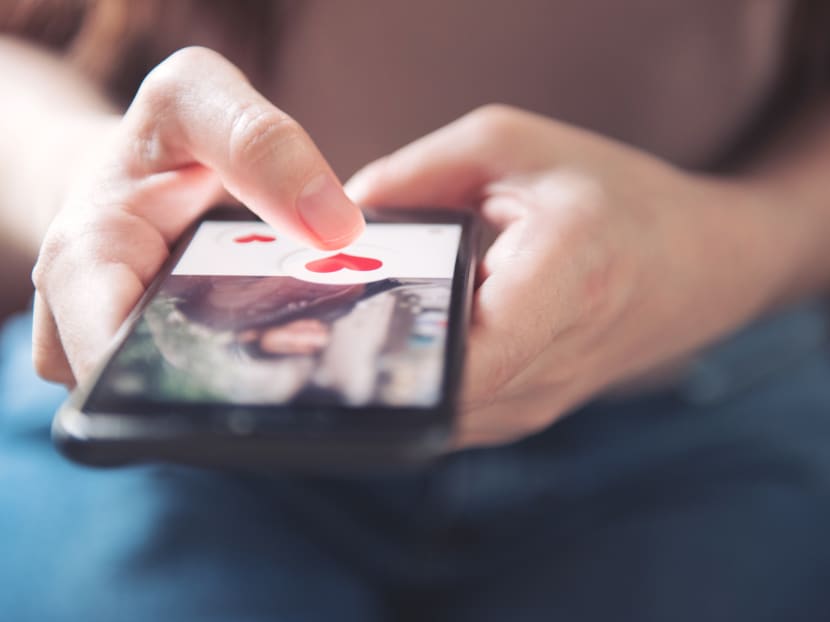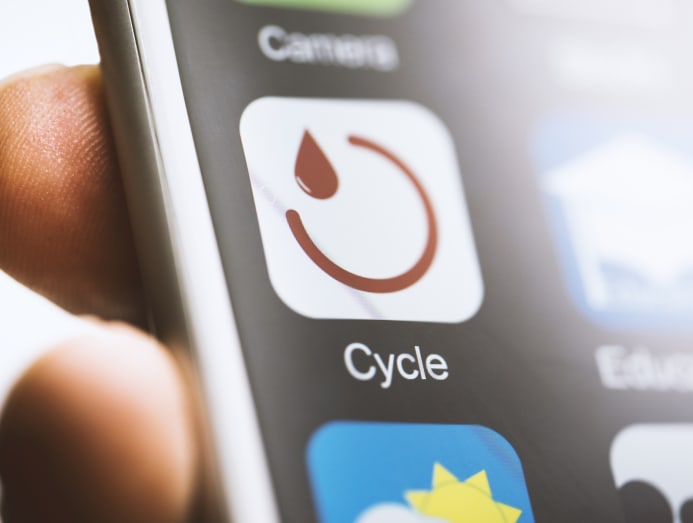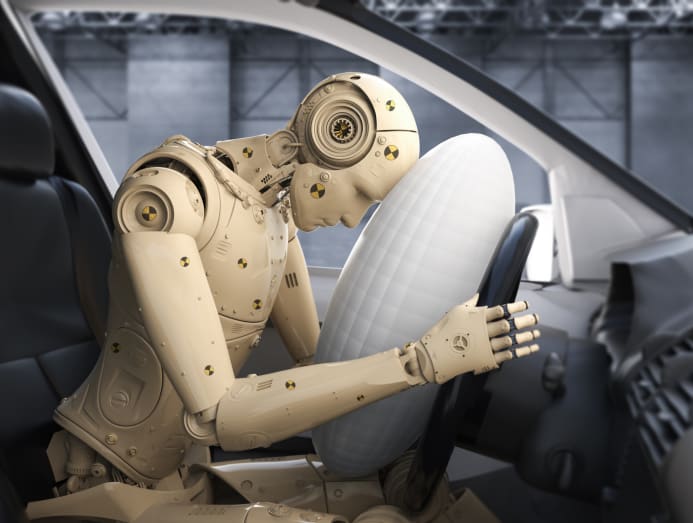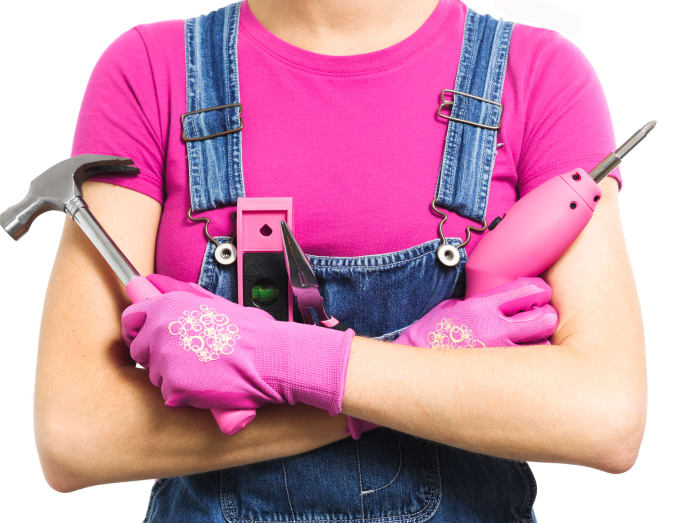From phones to face masks: Why some everyday products aren’t designed for women
Advertisement
Women
From phones to confront masks: Why some everyday products aren't designed for women
From cars and gadgets to life-saving medicine, products and services default to male specs, leaving women cold. CNA Women digs into how it's nevertheless a man's world – and how information technology'southward time to say goodbye to "pink it and shrink it" stereotypes when it comes to products for women.

Have y'all ever wondered why you need to concord your smartphone with both hands? It'southward because mobile phones are fabricated with men'south larger hands in mind. (Photograph: iStock/oatawa)
x Sep 2022 07:14AM (Updated: 12 Sep 2022 04:46PM)
Soul legend James Dark-brown sure wasn't kidding when he crooned that this is a man's world.
Despite companies pouring more money into product research and evolution than advertising these days – a Harvard Business Review report puts the ratio at 10 to 1 – it still feels as though many goods and inventions are simply non made with women in listen.
Have smartphones for instance. Because women's hands are typically smaller than men's past well-nigh 2.5cm or so, phones over 12.5cm are difficult, if not impossible, to employ with one mitt without fumbling or dropping. Yet phones are getting ever bigger, with the largest current models nearly 17.5cm in size.
This male-leaning tendency was noted in a 2010 expert paper on the gender dimensions of production design, prepared by a grouping of Danish researchers for the United Nations.
The newspaper concluded that there is a male gender bias in many tech products, and that differences in male and female preferences need to be considered in gild to create products that cater for women, likewise.

Many of the well-nigh pop health trackers, like Fitbit and Nike, did not accept a catamenia tracking function in their initial models. Neither did Apple tree'due south in-telephone Health app when it was first released in 2014, although it covered everything else from calorie count and respiratory rate to sodium intake.
In her 2022 study, information scientist and sociolinguist Dr Rachael Tatman plant there was a 70 per cent chance that Google's speech recognition software would register male speech communication more than accurately than female person.
Non that such disparity is express to the field of technology.
Think about power tools which are unwieldy and heavy for women to use, work chairs that are not ergonomic, food jars and can or bottle openers that aren't friendly to female person hand sizes and strength, and confront masks that don't fit well on women's faces.
More alarming still are the wellness and rubber consequences.
Since the 1970s, auto safety tests have been using crash dummies based on the 50th percentile male person trunk, which is considerably taller and heavier than the average woman. But despite various research showing that this puts women at far higher risk of injury than men, the first female person crash dummy wasn't developed until 2022 and is even so not mandatory in tests now.

Information technology'southward a similar story in medicine. In Singapore, CPR dummies with a female person physique just officially came into employ this yr.
Heart assault symptoms are based on male experiences, resulting in doctors possibly missing the status in women considering they display "atypical" signs.
And historically, medical enquiry and drug trials take either excluded women because their shifting hormones complicate results, or don't divide the findings by gender. Instead, it is just assumed that what works for men works for women, likewise.
MINDING THE GENDER GAP
It's been said that women are the most powerful consumers in the world today and the stats more than than back this up.
In the U.s., women influence 85 per cent of buying decisions and drive 70 to fourscore per cent of consumer spending. A Global Times report puts the female person consumer market in China in excess of x trillion yuan (Southward$2.08 trillion) in 2020, with women contributing 75 per cent of full household consumption and buying one-half of male person-targeted products.
And on a global level, market research firm Frost & Sullivan institute that the female economy is gear up to outpace some of the biggest nations' economies in the adjacent five years.
So and so, why is the male person gender however the default standard for production design while women'due south needs are not captured?
For an explanation to that, nosotros probably have to look at where the gender imbalance starts – the universities, pattern companies and engineering firms.

According to statistics from the Singapore University of Applied science and Pattern (SUTD), fewer than xx per cent of students enrolled in engineering and architecture in Singapore are females.
The picture looks better when you zoom out, with the Ministry of Instruction reporting that women accounted for 41 per cent of university students pursuing degrees in science, applied science, engineering science and mathematics in 2019. Nevertheless, only 30 per cent of local researchers and engineers are women.
Over in the Uk, a 2022 written report by the Design Council constitute that 78 per cent of its design workforce is male; this rises to a whopping 95 per cent in the sub-sector of product and industrial design.
Trechelle Lyn Ras, a learning designer at digital creative business school Hyper Island, who too teaches design and innovation modules, chosen this lopsidedness "the design debt that'southward been generated by years of male-dominated industries".
She added that achieving equal representation and inclusive design would require many things to fall into place. "Instruction, the availability of talent, the blueprint principles of companies, business opportunities, the technology that makes product possible, to proper name just a few. It's a whole system at play," she said.
For now, many companies simply fall back on the "pinkish information technology and compress it" game program, where products are made smaller, cuter and in a range of pretty hues without understanding what women actually want them to do. What good is a toy-sized drill or hairdryer or laptop with swirly floral patterns if information technology's underpowered and can't get the chore washed?
It goes to the heart of the trouble: A failure to grasp that gender – both the designer's and the user's – affects design.
" Often, designers forget they are designing for others and that they bear biases and views which can color the products they create. This takes a lot of awareness and backbone to acknowledge and many designers are just not still equipped with this level of introspection.
"They don't realise the responsibility they have to the creations they put out and the potential bear upon on users," said Ras.
LEVELLING THE Design FIELD
While all this may seem rather depressing, in that location are promising signs that things are, slowly but surely, looking up.
Associate Professor Yang Hui Ying, who specialises in engineering product development at SUTD, said that although there are sure gaps between males and females in terms of income, education, and employment, the situation on the whole has been improving for women over the past decades, especially in developed countries.
"Women now accept the same capabilities and opportunities to perform and excel in jobs and activities that used to exist done by men. Therefore, to rethink many of the ordinary items that we use in our daily life and design products with less gender bias is a very important task with huge potential market," she said.

She cited gender-neutral bicycles, which come in a wider fit range, with smaller incremental changes between sizes, enabling them to suit all riders. Household products like vacuum cleaners that used to be considered housewife items accept likewise evolved, taking a more than genderless form, such as cleaning robots.
Ras attributes the recognition of pattern's gender bias to the rise of feminist movements. "In the last few years, movements similar Me Likewise, Women'southward March and manels (all-male panels) have been pivotal in renewing interest in women's rights and shedding light on the plight of women living in a world dominated by men," she said.
With this growing awareness likewise comes an understanding that the problem goes back to the beginning of the pattern procedure, where at that place is a lack of female person representation in both the classroom and boardroom.
" I think information technology would exist improve if more female designers can join the engineering and technological industries so the opinions of female designers tin be heard, as there are nonetheless some disconnects between female consumer demands and the number of female designers at the table," said Acquaintance Professor Yang.
Echoing this view, Ras sees instruction as a powerful tool for bringing about change, not only by increasing sensitivity towards the issue but also by shaping the lenses that people have with them into the roles they play.
" Inclusive blueprint starts with inclusive teams. That is why at Hyper Island, we instil the importance of human-centred, collaborative teams. Sharing a wide range of disparate views is critical to creating a complete picture of a problem or need, and developing solutions that meet the needs of the many versus the few," she said.
CNA Women is a new department on CNA Lifestyle that seeks to inform, empower and inspire the modern adult female. If you take women-related news, issues and ideas to share with us, email CNAWomen [at] mediacorp.com.sg .
Contempo Searches
Trending Topics
stthomasolcou1970.blogspot.com
Source: https://cnalifestyle.channelnewsasia.com/women/world-designed-men-gender-bias-stereotype-278011

0 Response to "From phones to face masks: Why some everyday products aren’t designed for women"
Post a Comment